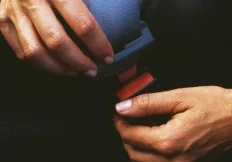
Although the idea of a belt being used to secure a person for safety purposes had been around since the 19th century and had been in use in airplanes since shortly after they were invented, they did not begin to become commonplace in automobiles until the late 1940s and the 1950s when a few auto manufacturers began to offer them as optional equipment. They did not become mandatory equipment in passenger vehicles in the United States until 1968.
Types of Seat Belts
Initially, most seat belt devices in U.S. automobiles were the simple lap belts that attach around a person’s waist. During the late 1960s and especially in the 1970s, many manufacturers also included a separate “sash” shoulder harness that would run from the occupant’s outside shoulder, across his or her body, to attach at the waist on the inside side of their body. In the 1970s, some manufacturers adopted an automatic sash-type shoulder belt that would move on their own around the occupants body once their door was closed or the engine was started. Although they had been developed in the late 1950s, the “three-point” harness that includes both a lap belt and a sash shoulder harness in a single unit didn’t become common until the 1980s.
Types of Seat Belt Injuries
Some seat belt injuries are associated with certain types of belt that have been discontinued. The “sash” type belt that goes from shoulder to waist without an attached lap belt (as in the 3-point harness), and especially the automatic shoulder restraints, were found to be quite dangerous when not used in conjunction with a lap belt. Without the extra restraint from a lap belt, a person’s body can “submarine” underneath the shoulder belt, sliding forward in the vehicle when the collision is from the front, often resulting in very severe injuries, even decapitation. The automatic version of these shoulder belts were largely dropped by manufacturers by the mid-1990s.
Lap belts were originally designed with adults in mind, and studies in Great Britain after seat belts were made mandatory found that lap belts alone actually increased the number of injuries and fatalities in children by about 10%. The problem was discovered to be that a seat belt that would ride around the lap on an adult would end up placed too high on the abdomen of a child, resulting in injuries to the abdominal organs and the spine. In vehicle where only lap belts are available, the use of booster seats can help to properly position the belts.
Even the more modern 3-point restraint systems that incorporate both a lap belt and a shoulder harness can still produce injuries simply because of the significant forces involved in motor vehicle collisions. Although much safer than some of the older restraint systems, these can produce significant chest and shoulder bruising where the shoulder harness crosses the body. It’s common for emergency room doctors to see bruising and friction burns in a stripe from the shoulder to across the chest, but obviously this type of injury is much preferred over the more serious impact injuries that could occur if no restraint was used at all.
Avoiding Seat Belt Injuries
The occurrence of injuries with and without different types of seat belts has been very carefully studied in recent decades, and the findings from these studies get incorporated into the design and instructions for new restraint systems. So with newer vehicles, the most important factor is to understand how the restraint system works and to follow the manufacturer’s instructions. For older types of restraint systems, it’s also important to understand what deficiencies have been found over time and to correct for them — in vehicles with separate sash or automatic shoulder harnesses, for example, it’s crucial to always wear a lap belt in conjunction in order to avoid “submarining” on impact. For plain lap belts, it’s important to make sure the belt is positioned low over the hips rather than higher across the abdomen where it is more likely to produce seat belt injuries. For children who have graduated out of child seats and harnesses to wearing regular restraints, but who are not yet adult-sized, booster seats can help position the lap belt at a safe level on their bodies.
I’m Ed Smith, a Sacramento personal injury attorney with the primary accident information site on the web, AutoAccident.com.
If you or a loved one has suffered an injury in a car accident — including any seat belt injuries — call me now at 916.921.6400.
You can find out more about our office by looking for us either on Yelp or on Avvo, the attorney rating site.
